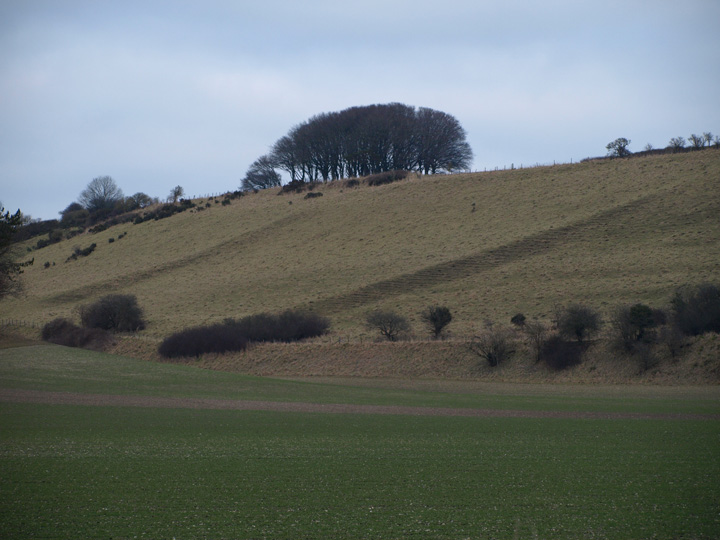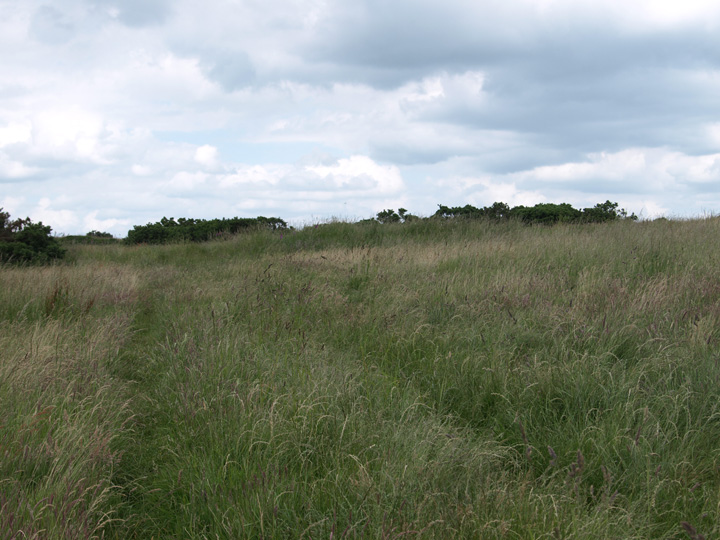



This is a beautiful place. I didn’t see another soul.

A close up of the eastern end of the bank.

Field boundaries sloping down from the main settlement. The clump of trees is where one of the barrows is.

What looks like an outer bank, from the Sydling valley below.

A possible field margin or enclosure bank.

Part of the bank of an enclosure.

A very overgrown bowl barrow.

A nicely preserved bowl barrow inside a small wood.

Grimstone Down from Penn hill.
I finally found the time to visit this site. I spent three hours here and barely scratched the surface. This is a massive place covering about one hundred acres. There is a lot to see, but like many similar sites it’s difficult to photograph, espescially when the grass is high.
Preserved in small woodland areas are several round barrows, two of which I managed to find. The most southerly is in fine condition with no obvious signs of damage. The second, near Jackman’s cross is very overgrown and difficult to get close to.
To the south across the valley of the Frome is the Penn hill / Seven barrow plantation, while to the north is Smacam down.
There is a good path up a gently sloping hill and stunning views for 360 degrees, well worth a visit for them alone.
Details of Settlement on Pastscape
(Centred SY 644956) Settlement (NR). (1)
A settlement on Grimstone Down consisting of traces of Celtic fields covering more than 100 acres. Towards the centre of the area, the fields become more clearly defined and between the field banks several hollowed tracks converge on a series of smaller enclosures; these show no traces of dwellings but probably represent the position of the main settlement (see plan). To the east of the dyke (SY 69 NW 39) are further remains of a Celtic field system extending some distance to the south. (2)
The excavation for a reservoir on Grimstone Down in 1950 at SY 64629530 revealed that the earthworks were of lynchet construction rather than the remains of deliberately constructed banks. The only internal feature observed was a small shallow pit (or trench?) near the centre of the east face of the excavation, which contained pottery sherds. The majority of sherds, however, were found in the excavation spoil and appeared to be all of Iron Age ‘C’ type with the exception of a few Iron Age ‘A’ and possibly ‘B’ sherds. About 40 yds from the south-east corner of the reservoir, the pumping-main trench sectioned what appeared to be an ancient trackway from the settlement, running a few yards west of, and parallel to the modern trace to Jackman’s Cross. (3)
SY 64719552. Late Romano-British pottery was found during 1969-70 in material brought to the surface of a trench dug for repairing the water-main on Grimstone Down. The trench revealed at one point, a layer of flint which coincided with field banks, still intact to the north and south. Three hundred sherds of Romano-British coarse ware, two sherds of New Forest ware, twenty-one nails and a small fragment of roof-tile were found embedded in the surface of the flint layer. No evidence of earlier occupation was found below the layer and it was suggested that the flint represented the scattering of an earlier field bank in the 4th century by Romano-British occupation. (4)

















































































































































